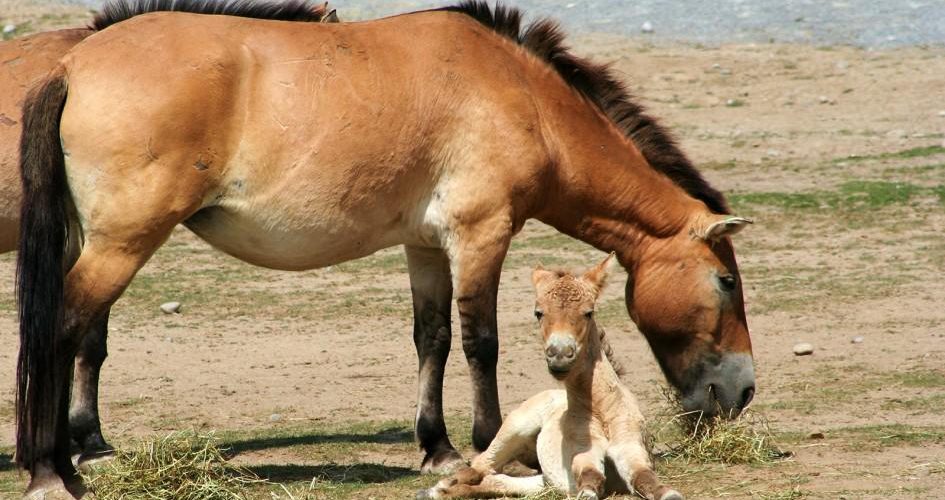We all love these highly intelligent caretakers of the jungles and savannas

How much beauty and wonder surround us! The world of nature is striking in its diversity, amazing harmony and wisdom.
Despite the fact that humanity has long been studying nature, our knowledge of it remains quite limited
Perhaps somebody doesn’t know that one of the most cognitive species on Earth does not sit behind a desk. But you will certainly find it roaming in the grasslands and tropical evergreen and deciduous forests of Southeast Asia, India and Africa and in African savannas. Inquisitive people have already guessed we’re talking about elephants.
Elephants are fascinating creatures. And it’s not just that they are the largest living animals on our planet.
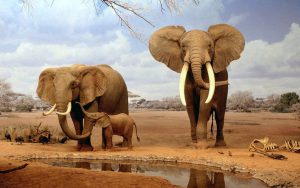
Elephants have a highly developed neocortex, or “thinking part” of the brain, which helps them form relationships and problem solve as they act as gardeners in their ecosystem.
The average lifespan of elephants is 50-70 years, but the oldest known elephant in the world was 86 when he died.
The Asian elephant and the African elephant
There are two distinct species: the African elephant and the Asian elephant.
The African elephant is divided into two subspecies: forest elephants and savanna elephants.
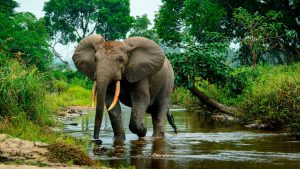

Asian elephants are on average 6.4 meters in length, 2 to 3.5 meters tall, and weigh around 5,000 kilograms. They are larger than African forest elephants but smaller in size than African bush elephants and stand out from both, having smaller, more modestly shaped ears.
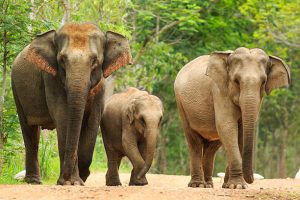
Their feet also differ from those of African elephants, for Asian elephants have more nail-like structures, with five on each forefoot and four on each hindfoot.
The Asian elephant is currently listed as an endangered species on the International Union for Conservation of Nature (IUCN) Red List. And to our greatest regret, its population continues to drop with every day. Some estimates have put the 50% population loss within the last 75 years and possibly as low as 20,000 Asian elephants are left in the wild.
A little more about elephants and their life
Elephants walk at about 4 mph, and they are able to swim long distances. They are, however, the only mammals which can’t jump. How fast can elephants run? Elephants have been clocked to run at 15 mph. However it is believed that elephants could run as fast as 25 mph though over a very short sharp distance
Adult elephants spend about 16 hours a day eating – they require up to 300kg of food and 160 liters of water every day. Elephants have 6 sets of molar teeth upon which they depend for survival. When the last set is lost, the animal is unable to eat and eventually dies of starvation.
The elephant’s trunk is a very impressive multi-tool. The elephant uses its long nose for smelling, breathing and trumpeting. But it can also be used as a hand to grab things. It is sensitive enough to pick up a blade of grass, and strong enough to rip the branches off a tree. The trunk also serves as a huge straw – elephants can suck up to 14 liters of water a time into their trunks and then blow this water into their mouths to drink. When bathing, they also use their trunk to spray themselves with water and mud.
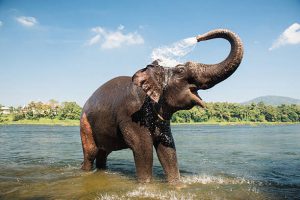
Amazingly, the elephant’s trunk has 40,000 muscles!
Elephants have very sensitive skin and use mud as a form of sunscreen. They need to take regular mud baths in order to protect themselves from sunburn, insect bites and moisture loss.

The elephant’s feet are covered in a soft padding that helps to support their weight, as well as to prevent them from slipping and dulling the sound of their footsteps. As a result, elephants can walk almost silently, despite their huge weight.
Furthermore, elephants use their feet to listen to the subsonic rumblings made by other elephants through vibrations in the ground. They have been observed to listen by putting their trunks on the ground and carefully positioning their feet.
Elephants’ senses and social behavior
Elephants have small eyes and poor eyesight, but they make up for this with their amazing sense of smell – the best in the whole animal kingdom! Elephants can smell water from up to 12 miles away.
They communicate with one another using sound, touch and scent. Their hearing is excellent. They can hear a trumpeting call from up to 5 miles away. They use a wide range of sounds to talk to each other – including those which humans are not able to hear.
Elephants are highly sensitive and caring animals, and have been observed to express grief, compassion, altruism, play and even sass. They perform greeting ceremonies when a friend that has been away for some time returns to the group, and they sometimes ‘hug’ by wrapping their trunks together.
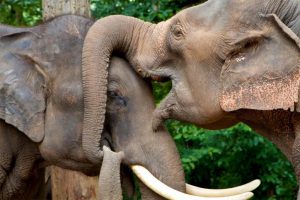
Elephants pay respect to the bones of their dead by gently touching the skulls and tusks with their trunks and feet.
Elephants are able to recognize themselves using mirrors. Such displays of self-recognition indicate a very high level of awareness, and that is something which only humans, apes, cetaceans and magpies are known to do.
Being extremely sensitive creatures, elephants have been known to display behavior patterns similar to post-traumatic stress disorder and depression.
Female elephants spend their whole lives living in tight family groups with their female relatives. The eldest female normally leads the group.
Male elephants leave the herd between the ages of 12 and 15, and usually live alone (although may sometimes form small groups with other males).
Elephants are extremely intelligent animals and have excellent memories. Matriarchs rely on this memory during dry seasons when they need to guide their herds, sometimes for tens of miles, to watering holes that they remember from the past.
Elephants are able to recognize and distinguish human voices. Surprisingly, they can tell the difference between human languages, male and female voices, friendly voices and those associated with danger.
The essential role of elephants in delicate African and Asian ecosystems
The elephants’ huge size means they can shape the landscape they are in. As they move around and feed, they create clearings in wooded areas, which let light in so that new plants can grow and smaller animals can survive.
They are a very important form of seed dispersal. Their nutrient-rich manure also helps replenish depleted soils so that humans can have a nutrient rich soil to plant crops in.
Elephants are important for other animals within the environment too. They dig waterholes when river beds are dry that other animals can use them as a water source, and their large footprints can create deep holes for water to collect in.
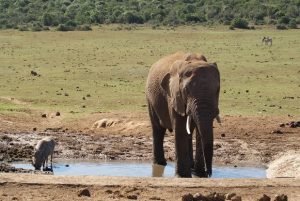
The wide trails that they carve through the vegetation as they move through the landscape can also act as fire breakers and water run-offs, and this makes it easier for humans and animals to access the forest and brush.
Challenges affecting elephant populations:
Unfortunately, elephant populations in both Africa and Asia are under threat due to the barbarian consumer attitude of humans towards these animals.
The word ‘elephant’ comes from the Greek word ‘elephas’ which means ‘ivory’. The rapacious ivory trade is the main cause why about 90% of African elephants have been wiped out in the past century.
Although many countries have now banned the ivory trade, more than 20,000 elephants are still killed every year to satisfy the demand for ivory.
































